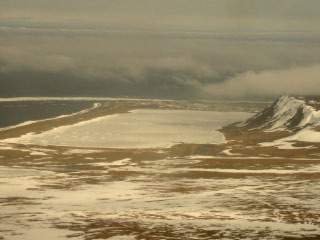 Day
18 - June 2 - Gambell
Day
18 - June 2 - Gambell Chapter 4. Western Alaska
 Day
18 - June 2 - Gambell
Day
18 - June 2 - Gambell (Bert) Getting up at 3:10 AM would seem especially early had I not been getting up before 5 these last few weeks. Bill and Jim are ready with their vehicles to take five us to the airport. Here we meet five other birders who will join us on the Gambell birding trip, including Lynn who I know as a fellow Texas Ornithological Society board member. No direct flights to Gambell exist, so our jet first lands in Kotzebue, above the Arctic Circle and on the coast of the Bering Sea. From the plane windows the only bird I see is a few Greater Scaup floating on a small pond beside the runway. We soon are in the air again, landing next in Nome. Here we change planes to a 19-passenger Beechcraft turboprop. While taxiing for take-off we see several caribou on the edge of the runway. Leaving at 9:50 for the 1-hr. flight to another side of St. Lawrence Island, we next land at Savoonga, once a reindeer camp, now a village of native Eskimos. The island is about 90 mi. long and only 8-22 mi. wide and is one of the last non-submerged portions of the land bridge that once connected Asia to North America. Before taking to the air again, Lynn and I see Snow Buntings along the runway. The turboprop levels off at 4000 ft. and makes the short flight to Gambell in about 10 min. Unlike two years ago, we enjoy good weather for landing and the multiple flights are uneventful. When we step out of the plane and face a bitter sea wind I am glad I put on all my extra layers of clothes before departure. Now I tighten up the zippers and snaps and meet Bob and James, the same excellent guides we enjoyed on our last visit.
We hike through the pea gravel to the house where we will be staying, the small and sparsely furnished home of a native villager that lives mostly in Anchorage. After wolfing down sandwiches for a late lunch we are anxious to start birding. The afternoon birding includes a few surprises for Gambell, including casual to rare Greater White-fronted Goose and Red-necked Grebe, the latter I found floating with Thick-billed Murres among the icebergs at The Point. Unquestionably though, the best birds are buntings and two in particular. Before we left on this trip someone asked me which bird I wanted to see at Gambell and I answered McKay’s Bunting. We hear of another good bird across the village and near the mountain, a long walk in the deep pea gravel. By the time we reach the spot about 20 min. later the bird is gone, but the birding group there has found a McKay’s. Looking very much like a Snow Bunting, the McKay’s has an almost all white back and I am delighted to get a good long look at this bird as it hops through the ancient bones in the pits of the Circular Boneyard.
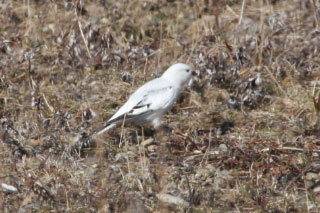
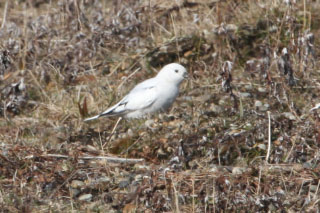
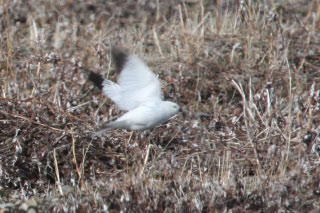

The second great bird is one I would not have expected to find, perhaps ever.
Three different birding groups are in Gambell, all voice-connected with pocket
radios set to the same frequency. A good sighting is shared by all, so in short
order we are all gathered at the Far Boneyard in the chase for the Little
Bunting that was seen briefly. Paul, one of the birding guides for another
group, takes charge of the search. Forty-four birders surround three sides of
the Far Boneyard with Paul standing partway up the mountain on the open end of
the “U”. Mostly we stand and wait for movement, often distracted by Snow
Buntings, Lapland Longspurs and Hoary Redpolls feeding in the boneyard. Paul has
the best perspective and alerts us whenever he sees the Little Bunting. If
needed, he steps forward a few paces to move the bird in our direction. I see it
in flight two times, but each time it lands behind a ridge in the diggings or
hides among the dry wormwood branches. After the third flight I get a good look
at the Asian rarity, a sparrow with chestnut portions to its head.

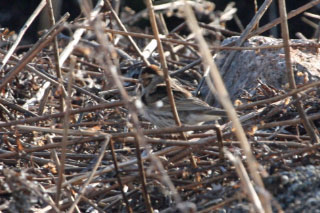
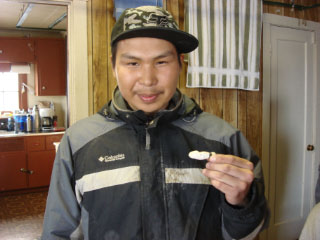 At 8:15 PM we return to the Far Boneyard to try once more for the Siberian
Rubythroat seen earlier by only a few birders. We do not find it again. We get
back to the house for a late dinner and several local craftsmen show up with
their delicately carved ivory. After inspecting several pieces, one catches my
eye because it intertwines nature with art. Part is a Bearded Seal claw, black
like ebony, and the other half is ivory carved into the body of a Bowhead Whale.
After my purchase I take a photo of Stanley Oozeva, the young artist, holding
his workmanship.
At 8:15 PM we return to the Far Boneyard to try once more for the Siberian
Rubythroat seen earlier by only a few birders. We do not find it again. We get
back to the house for a late dinner and several local craftsmen show up with
their delicately carved ivory. After inspecting several pieces, one catches my
eye because it intertwines nature with art. Part is a Bearded Seal claw, black
like ebony, and the other half is ivory carved into the body of a Bowhead Whale.
After my purchase I take a photo of Stanley Oozeva, the young artist, holding
his workmanship.
(Shari in Anchorage) When I warned everyone to take their raincoat yesterday, I hoped we would not need it. Our trip today takes us around Turnagain Arm looking for Beluga Whales, sheep and the occasional bird. Marie drives Steve, Nancy and me along the winding, windy, scenic route. Each time I drive this, the picture is different. Today we have gray clouds playing games with the white mountain peaks on a playground of gray choppy water. Last night I printed out a few geocaching spots but when we reach Portage Glacier, the rain is coming down too hard to look for those two sites. We watch the movie at the visitor center and roam around the museum before we drive through the train tunnel to Whittier. The tunnel was built during WWII and was only open to train traffic until 3 yr. ago. Now every hour the train alternates with cars through the 2.5 mi. tunnel. However, I sigh in relief when we emerge from the tunnel and see the train waiting its turn on the tracks in town. The rain is now a drizzle so Steve, Nancy and I decide to look for two caches close to the parked car before we go for lunch. “May” leads us to the spots and eagle-eyed Nancy finds the caches. We then go to the Whittier Inn for their clam chowder in a sourdough bread bowl. The disappointing soup is tepid, mostly bread, and lacking taste. Before the tunnel opens for return auto traffic we rush to find another cache. Steve finds this one. On the way home, patient Marie drops us off at two more cache sites. Nancy finds one and I find the last one. Someone used a fake rock and hid it under another rock but I knew it was the cache as soon as I saw the writing on it when I flipped it over with a stick. At 4, we meet under the pavilion for Maries’ great tasting peach dessert and start telling jokes. Steve has Ann repeat silly phrases after him, much like the twelve days of Christmas. Marlene tells a joke about a Fairy’s anniversary present and Bill talks about the genie’s wish.
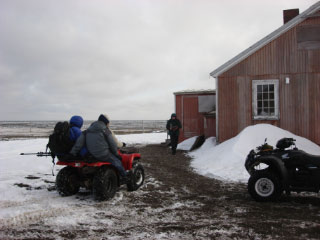
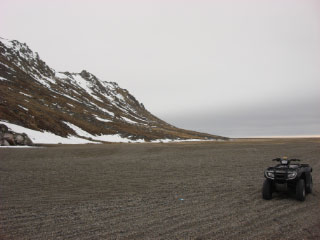
(Bert in Gambell) Late last night Martha delivered her 4-wheeler which I intend to rent for the next three days. Having drudged through the pea gravel for the duration of my previous visit to Gambell, I recognized the effort is exhaustive and we need the relief of the 4-wheeler to ferry us across the longest stretches to the birding sites. This morning I make a few practice runs, getting used to the awkward gear shifting with my oversized NEO’s covering my large hiking boots. I head to The Point where others have gathered already and see the Ivory Gull they have found floating on an iceberg, now aligned in a spotting scope. Our real trip of the day, however, is to go to the marshes on other side of the long lake. A 3-mi. road runs between the mountain and the lake. Water erosion has scarred gullies through parts of the road, but otherwise it is navigable. Along the way we stop to watch the Parakeet Auklets on the cliffs. Some are close enough for us to see the odd-shaped orange bills and the white feather plume extending from eye to back. We reach The Culvert, where a now deformed culvert once allowed easy passage over a mountain stream carrying ice water runoff from winter’s snow. Now the distended stream can only be forded by tall boots or by ferrying passengers across on the 4-wheeler. I watch as Bent and a few others walk across. Bob suggests I drive slowly and others recommend I drive near the rock dam. Two passengers mount the broad seat and we slowly make our way across the stream near the dam. Just short of the opposite shore the 4-wheeler plunges into a deep hole that I did not see nor had others mentioned. All three of us are thrown off the 4-wheeler and into the stream. The other two scramble out of the water quickly and mostly avoid getting wet. However, it takes me longer to get out and water rushes into the tops of my boots and soaks the lower parts of my pants and one arm. Worst, though, is that it splashes on to my 100-400 mm camera lens. Fortunately, and undoubtedly aided by the near zero speed we were travelling, no one is hurt, just wet. I turn the 4-wheeler around and cross the stream again, this time with ease and then easily ferry the other birders across, avoiding the hole and staying in the shallow water. Too wet to continue though, I return to the house and spend most of the day with my clothes in the dryer and my boots and NEO’s propped up against the space heater after pouring out a pint of water from each. The camera lens has droplets of water adhering to the inside and water oozes out of the slide mechanism. I let it air dry, but am not very hopeful of a quick recovery. Just as the last boot is dry the others return, having seen a pair of Common Ringed Plovers, but not relocating the Red-necked Stint seen previous days by other groups.
Before dinner and now with dry clothes, I am anxious to see at least a few birds today. We head to the Far Boneyard and some of us are rewarded with seeing two Bluethroats and an even better view of the Little Bunting. A Red-throated Pipit has been spotted near the airport runway, so I ferry passengers to the site and we all get long looks at a somewhat distant and evasive female. After dinner, five of us head out on foot and the 4-wheeler to a special spot where the mountain meets the sea. Icebergs have drifted out of sight, the sea calm, the winds stilled. Glaucous Gulls and Pigeon Guillemots stream over the water. Alcids sing from the mountain top and flocks of hundreds circle above us and across the sea in long files. Crested Auklets rest on black rocks and their dark crested feathers are silhouetted against white snow drifts. Least Auklets fly like swallows around the cliffs. It is late by the time we return the long distance to the house and the air is frigid, especially when it hits me in the face from aboard the 4-wheeler. It won’t be hard to fall asleep tonight.
(Shari in Anchorage) I go along with the group again today. Arctic Valley is a place I have never visited and while the group birds, I read. We have a terrific view of Anchorage from a pullout high above the city. I eat a great Chinese buffet with Chris, Curt, Bill, Ginny, Bill, Marlene, Steve and Nancy in Eagle River before driving to the Eagle River Nature Center, another place I have never visited. Steve, Nancy and I walk a guided nature trail all the while bemoaning that we did not bring any cache coordinates with us. Back at the Nature Center, Steve spots a geocaching decal on the window and Nancy asks about any caches in the area. The man behind the desk pulls out an ammo box and it is another cache for us. Granted we did not have to work very hard for that one but I intend to add it to my list. We end the night in front of Bill and Ginny’s for one of those socials that keeps growing with time, starting with two people, then four, then five, six, seven and nine. When the sun gets low in the sky and hides behind a cloud it gets cold and we go back to our rigs.
(Bert in Gambell) We head back to the same mountain-meets-sea spot we were late last night. Fog and below freezing cold weather has set in and the auklets have moved down the mountain to rocks more easily viewed. To my delight, hundreds of singing Parakeet and Crested auklets are in easy view. Usually we see these distantly from The Point as flocks fly by, or at other Alaska sites we see them far off while birding from a rocking boat. Bob calls us on the radio and we move to his location farther inland along the edge of the mountain. He has two Dovekies lined up in his scope. They are high up on the cliffs and from this perspective they look like tiny black-and-white balancing balls on a huge boulder.

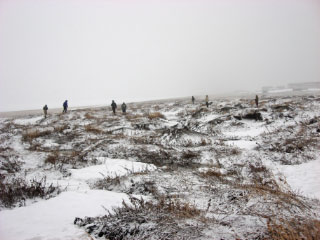
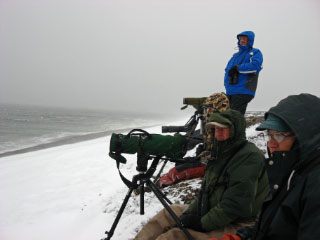 None of the other birding groups are in sight and in the stiff winds we walk
through the Far Boneyard. I’m completely wrapped in multiple layers of clothes,
but part of my face is exposed. When facing north the pellets of ice crystals
sting my face and eyes, making it hard to see birds, so we walk south with the
wind at our backs. Most of the longspurs, buntings and redpolls are hunkered
down, but I see one Rock Sandpiper in clear view before it takes flight. I call
to the others and they meet nearby to get another look at the bird. It and
another make a second flight and several others see it before the two hide so
tightly we cannot find them again. Bent and I walk to the Northeast Marsh and
here we get a much closer view of a male Red-throated Pipit.
None of the other birding groups are in sight and in the stiff winds we walk
through the Far Boneyard. I’m completely wrapped in multiple layers of clothes,
but part of my face is exposed. When facing north the pellets of ice crystals
sting my face and eyes, making it hard to see birds, so we walk south with the
wind at our backs. Most of the longspurs, buntings and redpolls are hunkered
down, but I see one Rock Sandpiper in clear view before it takes flight. I call
to the others and they meet nearby to get another look at the bird. It and
another make a second flight and several others see it before the two hide so
tightly we cannot find them again. Bent and I walk to the Northeast Marsh and
here we get a much closer view of a male Red-throated Pipit.
Birding later at The Point, we slip just over the edge of the gravel hills so we are blocked from the chilling winds. Sitting on cushions we comfortably watch the bird parade. The weather forces the birds to take a circular feeding pattern whereby they follow the winds out to sea and then return along the shoreline where the winds are calmer. To our advantage, this brings the birds much closer to our viewpoint. We study King Eiders, Red Phalaropes, Vega Herring Gulls, Sabine’s Gulls and repeated views of Ivory Gulls.
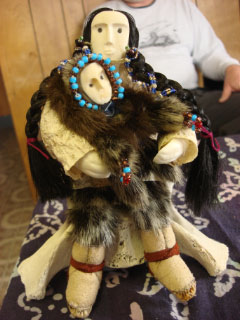 During dinner, Beulah, a village lady perhaps about our age comes to the
house and shows us her dolls which have become well known as Beulah Dolls. About
8 in. high, this one is of a seated Eskimo woman holding her baby, both dolls
are clothed in seal skin fur, have intricately carved ivory faces and hands and
other adornments made from native materials. Her “chair” is an ancient bone
fragment, perhaps from a walrus. The setting gives me the feeling she is
patiently sitting at the seafront, waiting for husband to return from a whale
hunt. It doesn’t take Bent long to decide he wants to buy this beautiful doll
for Marie.
During dinner, Beulah, a village lady perhaps about our age comes to the
house and shows us her dolls which have become well known as Beulah Dolls. About
8 in. high, this one is of a seated Eskimo woman holding her baby, both dolls
are clothed in seal skin fur, have intricately carved ivory faces and hands and
other adornments made from native materials. Her “chair” is an ancient bone
fragment, perhaps from a walrus. The setting gives me the feeling she is
patiently sitting at the seafront, waiting for husband to return from a whale
hunt. It doesn’t take Bent long to decide he wants to buy this beautiful doll
for Marie.
We hear that Red Knots have been seen at the South Marsh. Most of the birders look at the foul weather outside and decide the knots are not worth the effort, but Bob and I start talking about their rarity on Gambell and that neither of us have seen them here. So, without further discussion we decide to take the 4-wheelers – we now have two – and Bob, James, Bent, John and I head out in the storm. Going south with the wind is the easy part and in about 20 min. we reach the marsh and within minutes we find two Red Knots as well as Western Sandpipers, Dunlins, Rock Sandpipers and the more common longspurs and buntings, all enduring the harsh winds across ice and snow while they try to find bits of food along the pond shore. We try visiting another marsh area, but the winds have started making snow drifts and we cannot see anything through binoculars when we aim into the wind. So, we head back facing winds of 25-30 mph, plus driving at 20 mph. The snowfall is not fluffy and soft. Instead, it has formed ice pellets that clink when they hit my glasses and sting like stones when they hit the part of my face not already covered by my jacket hood, stocking cap and baseball cap. I am glad Bob is in the lead, because the snow blizzard has made the path indistinguishable from the ice covered lake and the snow covered gravel. We plunge through 4-5 in. of snow with the 4-wheelers and I suspect a snow machine would do as well tonight. I remind myself, the month is June.
An hour or so later the winds have abated somewhat and the snow blizzard has subsided. At 9:15 PM some are thinking about getting to bed early. Just then the personal radios buzz the announcement that a Jack Snipe is being seen at the Northeast Marsh. Almost everyone jumps to attention and scrambles to get their layers of clothes back on and pull their boots and overshoes over their feet, grabbing binoculars but forgetting cameras. I’m the first out of the block and carry two passengers with me to the marsh. We run across the difficult tundra to where a line of spotting scopes point to the spot where the Jack Snipe feeds feverously. I get a great look at the snipe and see how it differs from Wilson’s Snipe. We look around to see who is not here and I decide to head back to the house for Bent and either Barb or Joann. Bent is ready to go when I arrive and Barb is at first reluctant then decides to get dressed and join us. When we get back to the marsh the snipe is still there and we get more good looks, even as close as 25 ft., quite amazing for a bird that is known to be a recluse. How rare is it to see a Jack Snipe? I’ve seen one in Ireland, but am not aware of North American sightings. I am told there are only two prior records for Alaska, plus sightings in California and Labrador. For every one of the birders on Gambell this is a life bird in the AOU area, including all of the birding guides. For James, it is his 850th life bird for North America.
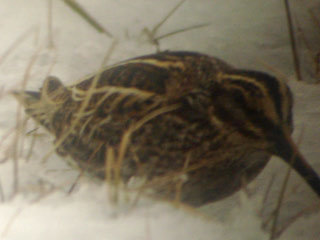
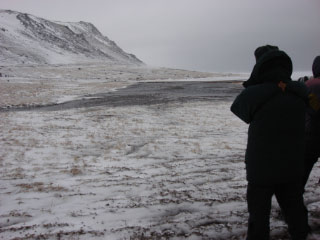
(Bert in Gambell) We try to relocate the Jack Snipe at the Far Marsh, but do
not find it and see little else besides. I am anxious to visit the South Marsh
again, since I missed it two days ago, and the rest want to try it again. At the
lake near the marsh, three of us are watching the Red Knots at the same spot we
found them last night when we hear a Gray-tailed Tattler has been spotted. We
hop on the 4-wheeler
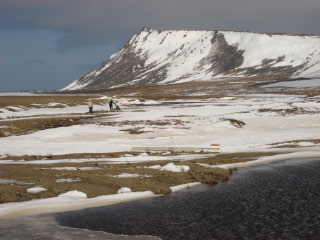 and quickly get to the place where other birders have
gathered. The tattler feeds along the creek where I had the 4-wheeler mishap. On
the edge of the lake a Slaty-backed Gull takes flight with Vega Gulls and flies
to a distant spot on the ice. Even with spotting scopes, the view of the Slaty-backed
is poor, yet it is the first of our trip. The rest of our group catches up with
us and spends more time watching the tattler and then continue exploring the
marshes, some still covered with ice and snow. We find a Pectoral Sandpiper and
it’s my turn to see a pair of Common Ringed Plovers that others saw earlier.
Although very similar to Semipalmated Plovers, I can see four distinguishing
marks: white supercilium, absent orange eye ring, more orange on the bill and
broader dark necklace. A Rough-legged Hawk takes flight and comes to a landing
not far away. It has caught a rodent and proceeds to shred its prey.
and quickly get to the place where other birders have
gathered. The tattler feeds along the creek where I had the 4-wheeler mishap. On
the edge of the lake a Slaty-backed Gull takes flight with Vega Gulls and flies
to a distant spot on the ice. Even with spotting scopes, the view of the Slaty-backed
is poor, yet it is the first of our trip. The rest of our group catches up with
us and spends more time watching the tattler and then continue exploring the
marshes, some still covered with ice and snow. We find a Pectoral Sandpiper and
it’s my turn to see a pair of Common Ringed Plovers that others saw earlier.
Although very similar to Semipalmated Plovers, I can see four distinguishing
marks: white supercilium, absent orange eye ring, more orange on the bill and
broader dark necklace. A Rough-legged Hawk takes flight and comes to a landing
not far away. It has caught a rodent and proceeds to shred its prey.
We return to the house and then to a sea watch at The Point. The water is calm, devoid of icebergs. Through the clear skies we can see the mountains of Siberia across the Bering Sea. In the distance Gray Whales blow and I see one surface, arch its back and submerge. We enjoy a constant parade of bird life and especially the loon show, counting two Red-throated, two Arctic, dozens of Pacific, and four Yellow-billed. First a single and than a pair of Yellow-billed Loons fly close to The Point where we sit on the gravel, with snow at our feet. At a distance the Yellow-billeds appear as they have no bill at all, the yellow melting into the background sky. But close up the large bills are obvious and so different from the other loons.
Since I am returning the 4-wheeler this evening, I go to the village store – the only one in Gambell and a gathering place for locals – to refuel. Gasoline is $5.85 per gallon, which probably is a good price considering how hard it is to transport it to Gambell. While I am checking out at the register, the young man ahead of me is buying Pampers, a couple of cans of food and a box of shotgun shells. His bill comes to $175. He tells me he needs the shells since he used up his supply this afternoon while hunting geese. He shot one Greater White-fronted Goose and three Snow Geese and tells me his family will eat well tonight.
Before retiring for the evening we walk to The Point, the weather idyllic and the scenery magnificent. It is the kind of evening where you just don’t want to go home because all of your senses are absorbing a grandeur that is intoxicating. Our last view is of Red Phalaropes floating in a calm sea with a Dovekie among them.
(Shari in Anchorage) “I like the way Jim conducts the bird counts better”, I say this evening at our social. He starts with mammals seen, allows for caches found and then gets to the birds. It does not take us long to get done with the bird counts because very few birds were seen these past four days. Apparently today’s outing was the best. I did not join the group but spent my day washing clothes, backing up my computer and paying bills. After the bird count, I talk about our time in Nome, what to expect, what to bring, etc. After dinner, Marie has invited Steve, Nancy and me to play hand and foot. The rules are totally different from the game I played in Colorado and that must be the reason Steve and Nancy beat us. Afterwards we play “Blockus” another new game for me played with tiles and a board. It too is fun even if I am not a winner. We were only going to play until 8:30 but we are having so much fun that before we know it, it is 10 PM.
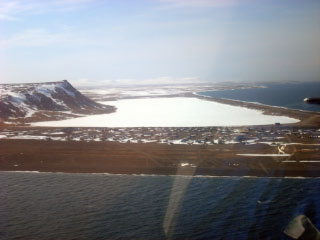 (Bert) With not much time to bird before our plane leaves, we head to The
Point. An idyllic morning, the skies are clear and the temperature warm or at
least warm compared to prior days. I see several flocks of Harlequin Ducks and
more Brants, species others had reported but I’d missed. At last night’s bird
count we brought the total species seen on Gambell the past few days to 71,
including 2 seen only by our guides. Of these I saw 65, including three lifers:
Jack Snipe, McKay’s Bunting and Little Bunting. Summing up the lifers for all 10
birders and 2 guides came to 181. Many more would have been lifers for me had
this not been my second trip to Gambell.
(Bert) With not much time to bird before our plane leaves, we head to The
Point. An idyllic morning, the skies are clear and the temperature warm or at
least warm compared to prior days. I see several flocks of Harlequin Ducks and
more Brants, species others had reported but I’d missed. At last night’s bird
count we brought the total species seen on Gambell the past few days to 71,
including 2 seen only by our guides. Of these I saw 65, including three lifers:
Jack Snipe, McKay’s Bunting and Little Bunting. Summing up the lifers for all 10
birders and 2 guides came to 181. Many more would have been lifers for me had
this not been my second trip to Gambell.
I come back to the house to pack the last of my things. Bob tells me he received a phone call that the charter jet hit a bird while leaving Nome and had to go to Fairbanks for repairs. That means the airline must substitute its 9-passenger plane and will have to carry the 12 of us back in two flights. Bent and John stay back with Bob and James, catching up with us in Nome at about 3:30 PM. Meanwhile I’ve gotten a rental car for us and after dumping our things in the hotel and grabbing a sandwich at Subway’s – the only nationally named restaurant in Nome – we are again birding, this time on the Teller Road heading north out of Nome.
 Although I usually find Teller Road to be good scenery but few birds, we come
upon some interesting sightings tonight, starting with a herd of eleven caribou.
Nome is a good place to find golden-plovers and we get to see both American and
Pacific species, readily distinguished by the short or long lateral stripe from
head to body, respectively. A Wandering Tattler sticks to the edge of Snake
River. I can see the underside barring extends to the belly, unlike the
Gray-tailed Tattler we saw yesterday. We are on the way back to Nome when a
Rough-legged Hawk springs from the tundra and is immediately attacked by a
Long-tailed Jaeger and an Arctic Tern. It must have gotten too close to a nest
and these defenders are relentless in their pursuit of the intruder. Not 5 min.
later we see another chase. This one is a Mew Gull and Herring Gull attacking a
raven. Elsewhere, I have seen ravens carry off eggs in their bills and even work
in pairs in their sneak attacks. This time the gulls are the successful team.
Although I usually find Teller Road to be good scenery but few birds, we come
upon some interesting sightings tonight, starting with a herd of eleven caribou.
Nome is a good place to find golden-plovers and we get to see both American and
Pacific species, readily distinguished by the short or long lateral stripe from
head to body, respectively. A Wandering Tattler sticks to the edge of Snake
River. I can see the underside barring extends to the belly, unlike the
Gray-tailed Tattler we saw yesterday. We are on the way back to Nome when a
Rough-legged Hawk springs from the tundra and is immediately attacked by a
Long-tailed Jaeger and an Arctic Tern. It must have gotten too close to a nest
and these defenders are relentless in their pursuit of the intruder. Not 5 min.
later we see another chase. This one is a Mew Gull and Herring Gull attacking a
raven. Elsewhere, I have seen ravens carry off eggs in their bills and even work
in pairs in their sneak attacks. This time the gulls are the successful team.
(Shari in Anchorage) “The car is done; the car is done”, I sing to myself. I am no longer shackled to R-Tent-III. I immediately ask Jim if he could drive me to pick up the car. After I shed $1300 for the repair, I go shopping. Anchorage has the nicest REI store I have even entered and I must spend 2 hr. browsing. Then I go to Sears and to the bank. I also have two geochaches in “May”. Should I look? Yes. One is very easy to find but the other takes me on a golf course, over a fairway and through woods. I remember Steve telling me the cache was in a golf ball but I do not see any golf balls not in play. I start to look under rocks. There is a rock leaning against a tree and I move it aside and there is a golf ball with the word “geocache” written on it in red. I open the plug in the ball and take out the small log to write my name on it. I wonder if I am addicted to this? My mother always said you were an alcoholic if you drank alone before noon. Well I am out geocaching alone before noon. Does that make me a geoholic? I must say I get a rush finding the cache. Now it is time to pack for our trip to Nome. As I load the washing machine, I hear a knock on the door. It is Nancy, asking if I want to go geocaching with them. I tell her no. She says that that are only going for an hour or so. Okay, you twisted my arm. I shut off the washing machine and leave packing for later. We find six caches within 2 hr. and come home just in time for social at Bill and Ginny’s.
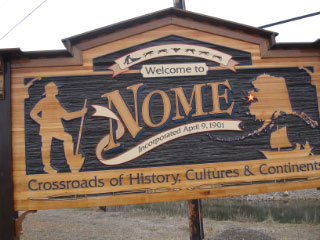 Day 23 - June 7 - Nome
Day 23 - June 7 - Nome
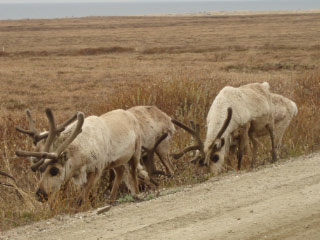 (Bert) The five of us from Gambell bird in the morning before the gang from
Anchorage arrive by plane. We head out the Council Highway, stopping first at
the dredge ponds where we see the first of many Red-throated Loons and
Red-necked Phalaropes today. I hope to find Bar-tailed Godwits at Nome River
and, in fact, we see 3-4 on the hillside. A distant sitting Snow Goose is a good
find and we pick up both American and Pacific Golden Plovers. Along the Council
Highway we pause for caribou along the road. Our next stop is
Cape Nome where we watch 22 Red-breasted Mergansers bounce in the Bering Sea and
when we turn to look up at the cliffs we see a Peregrine Falcon soaring. Later
at a hotel where we pick up more rental cars, we talk to a local worker who
tells us about the nesting falcons and how he captured one of the nestlings last
year for a falconer, by permission of the Alaska Fish and Wildlife Department.
The department had given the okay to local workers to destroy the nest since it
interfered with their digging and construction. But instead, the workers were
careful and worked around the nest and the falcons fledged successfully.
(Bert) The five of us from Gambell bird in the morning before the gang from
Anchorage arrive by plane. We head out the Council Highway, stopping first at
the dredge ponds where we see the first of many Red-throated Loons and
Red-necked Phalaropes today. I hope to find Bar-tailed Godwits at Nome River
and, in fact, we see 3-4 on the hillside. A distant sitting Snow Goose is a good
find and we pick up both American and Pacific Golden Plovers. Along the Council
Highway we pause for caribou along the road. Our next stop is
Cape Nome where we watch 22 Red-breasted Mergansers bounce in the Bering Sea and
when we turn to look up at the cliffs we see a Peregrine Falcon soaring. Later
at a hotel where we pick up more rental cars, we talk to a local worker who
tells us about the nesting falcons and how he captured one of the nestlings last
year for a falconer, by permission of the Alaska Fish and Wildlife Department.
The department had given the okay to local workers to destroy the nest since it
interfered with their digging and construction. But instead, the workers were
careful and worked around the nest and the falcons fledged successfully.
With extra cars now we head to the airport, shuttle the others to the hotel and then break for lunch. We repeat this morning’s run, but now are encumbered with fog, rain and snow. Through the precipitation we watch American Tree Sparrows and Hoary Redpolls at the dredge site, stop again at Nome River where this time I see the Ruddy Turnstone I missed earlier, and then continue to Safety Sound. Although the weather makes birding difficult, enthusiasm is not dimmed. We find a Pectoral Sandpiper, several Semipalmated Sandpipers – among dozens of Westerns – Common Eiders and a Sabine’s Gull at the bridge. Continuing to Solomon River the shortened backdrop of fog and snow prevents seeing all of the ponds and marsh, yet we see countless Tundra Swans, Greater Scaup and nine other duck species. At the Solomon River bridge, in the rain we find two more Pectoral Sandpipers and a Bank Swallow. One of the best birds of the day is the five Yellow Wagtails we find at four locations between the dredge and Solomon River bridge. Despite the weather, we are off to a good start in Nome.
(Shari) Looks like a whole bunch of people got up an hour early. As I take out the garbage I meet Betty, John and Donna. They are all ready to go as are Nancy and Steve. We are just chomping at the bit to get to Nome and as excited as little kids waiting for Santa Claus. Our flight takes us next to Mt. McKinley and I take some fantastic pictures through my window of the mammoth snow-covered mountain looming above the landscape. As we approach Nome, we see clouds and fog. Bert, John, and Bent are already at the airport waiting for us with our rental cars to take us to our hotel. Everyone is in a hurry to eat and then bird so we take the group to Subway for lunch. I let the group go out birding without me and I walk the streets making dinner reservations for each of the evenings we are to be here. I am so sure that I know where a cache is hidden that I do not turn on May until I get close. Boy, am I surprised to find that the cache is back where I started after lunch. By this time the snow is falling heavily and I decide to go out another day. I wait for the crew to come back and we all eat a tasty meal at Milano’s. Unfortunately two of our favorite restaurants have closed in Nome and the others must take up the slack. I always think it funny to find sushi at an Italian restaurant and pizza at a Chinese one. The pizza place serves steaks and hamburgers and the Chinese place serves Korean dishes as well as Alaskan fried seafood with fries. Only one restaurant is open early for breakfast and they are unable to take the group until 7:30 AM. I know that will be too late for Bert so I convince them to open at 5:30 instead. We have a hearty discussion over dinner listening to all the new birds seen this afternoon and hearing tales from Joanne, Mel, Bent, John and Bert about their Gambell experiences.
(Shari) Oh my God, I feel miserable. I could not sleep last night and I watched the clock click off the minutes. Finally at 2 AM I get up, close the bathroom door and read a few chapters in my fifth Harry Potter book. I fall dead asleep a little after 3, do not hear my alarm but hear Bert in the bathroom. I only have 15 min. to get ready for breakfast and I feel miserable. I walk the two blocks to the Polar Café in a fog, order in a fog and I think I talk to those at my table, but I am not sure. I had decided to accompany the group on the Kougarok Road hoping to see Muskoxen, Grizzly and Moose. Now we have been gone 2 hr. and only have traversed 9 mi. We have 65 to go this day. John spots a Grizzly and the Grizzly spots us. The bear hightails it up the mountain and every once in a while looks back at us. We also see a Moose and her calf and we think we have saved that little calf from the claws of the Grizzly. Later we get a great look at a Beaver. He sits in the shallow part of the river long enough for Mel to take pictures and then swims underwater toward us. The river is so clear that we watch his tail propel him under the bridge where we stand. Our next stop is a campground and Bluethroats. The birds are displaying and all of us eventually get good looks at them. I have a terrific view of a male singing so hard it looks like his heart is going to pop right out from his throat. One of the cars is low on gas and will not make it to the end of the road. After lunch five of us are ready to drive back so we shuffle scopes, coats and people between vehicles and get those wanting to go back into one car. Two hours later we pull into a gas station traveling only 40 mi. on the gravel road but using most of the 3/8 tank of remaining fuel. We take the opportunity to shop at the grocery store. I never knew this store existed and it is huge, having everything you need at outrageous prices, like milk at $6.59 per gallon. I want to see Muskoxen so bad that we take a little detour before going back, but find no animals. The remainder of my crew comes dribbling in over the next 6 hr. You guess it: Bert is the last to arrive close to 8:30 PM. I join him and Chris and Curt for dinner, having such a great time that we don’t wrap it up until we realize it is almost 10.
(Bert) Today is a day for big adventure and I want an early start, pack lunches for an in-route break and not return until this evening, for we will be driving the Kougarok Road inland about 72 mi. Just 3 mi. from town we get our first Moose, but the best ones are at mile 17. From the higher perspective of the road, we see a Moose and calf ambling along Nome River in a series of oxbows through a marsh below. Nearby a Grizzly Bear heads away from us and toward the river, yet does not turn in the direction of the moose calf and instead heads up the mountain side, turning occasionally to look towards us. A bit downstream from the cow and calf is another moose, perhaps the antlerless bull. One of the neat things about traveling the roads of Nome is the long distances we can see across the tundra and mountains with low vegetation that reveals numerous mammals and birds.
Jim’s carload spots a Snow Bunting and I turn our vehicle around for those that weren’t at Gambell where the species is common. Not so at Nome at this time of June, so we are lucky to get these. Our stop at the bridge over Grand Central River brings us a dozen species, including Harlequin Ducks. With everyone looking in a different direction I see a shorebird swiftly fly above us and over the bridge and yell, “Wandering Tattler” followed with directions to the spot across the river where it landed. Probably the most interesting find, though, is the Beaver swimming in the crystal clear mountain stream. We watch it along the riverbank and then it swims towards us and under the bridge. We get an incredibly good view of its underwater motion just below us.
We stop again at the primitive campground at Solomon Lake, now mostly covered with snow. A Say’s Phoebe singing from a highly peaked roof is our second of the day. This spot is well known as a nesting area for Bluethroat and it doesn’t take us long to find one and then a couple more in the next half hour while we eat lunch. The Bluethroat is a highlight for most in the group, an uncommonly beautiful bird with a bull’s eye pattern on its breast.
One car is low on gas, perhaps owing to a faulty fuel gauge, but not wanting
to take chances Shari takes a carload back to Nome. She is disappointed to hear
later that when we continue on the Kougarok just about 10 mi. farther we find a
herd of 35 Muskoxen grazing on the mountainside. Another good stop is near mile
64 where we find Yellow Wagtail, Pomarine Jaeger, Black Scoters, Cackling Geese
and Tundra Swans. I try to keep the group moving to our final destination, but
we continue stopping for birds, next about 6 mi. farther for Short-eared Owl and
Whimbrel.
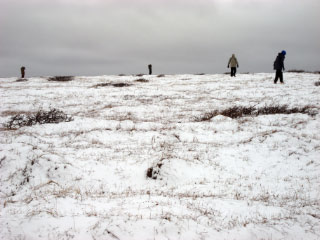 Finally we reach Coffee Dome and begin the climb of the mountain on
the opposite side of the road. I had warned our group about the difficulty of
climbing and when they start hiking the reality sets in. It’s not that the
upward slope is so steep, but that the tundra tussocks are too unstable to rest
a shoe atop and each step ends in a watery hole surrounding each mound. High
steps, low water, uneven terrain and navigating over dwarf birch makes upward
progress slow and tiring. A few turn back but the rest of us climb 1.02 mi. to
the top at 960 ft., with an elevation climb of 360 ft., according to Steve’s
GPS. Once there, we still have no assurance of seeing the much sought-after
Bristle-thighed Curlew. We wander around the mountaintop, the terrain somewhat
easier to hike than the climb up, and radio each other with sightings of
Sandhill Crane, Hoary Redpoll, Lapland Longspur, Savannah Sparrow, Common Raven,
Willow Ptarmigan and American Golden Plover, but after two hours of walking we
still have not seen the curlew. The best, though, is a pair of Short-eared Owls
that flutter together on the mountaintop. Steve and Nancy have headed downhill
to join others that either didn’t attempt the climb or have already descended
and John, Bent, Mel and I continue the search. We are about to give up when we
see in the snowfall a distant bird that has the shape of the curlew, but the
call sounds like a Whimbrel to me. We return to the opposite slope of the
mountain and hear it a few more times but do not see it. Finally, after
searching in another quadrant and now quite sure we have covered the whole
mountaintop we also retreat.
Finally we reach Coffee Dome and begin the climb of the mountain on
the opposite side of the road. I had warned our group about the difficulty of
climbing and when they start hiking the reality sets in. It’s not that the
upward slope is so steep, but that the tundra tussocks are too unstable to rest
a shoe atop and each step ends in a watery hole surrounding each mound. High
steps, low water, uneven terrain and navigating over dwarf birch makes upward
progress slow and tiring. A few turn back but the rest of us climb 1.02 mi. to
the top at 960 ft., with an elevation climb of 360 ft., according to Steve’s
GPS. Once there, we still have no assurance of seeing the much sought-after
Bristle-thighed Curlew. We wander around the mountaintop, the terrain somewhat
easier to hike than the climb up, and radio each other with sightings of
Sandhill Crane, Hoary Redpoll, Lapland Longspur, Savannah Sparrow, Common Raven,
Willow Ptarmigan and American Golden Plover, but after two hours of walking we
still have not seen the curlew. The best, though, is a pair of Short-eared Owls
that flutter together on the mountaintop. Steve and Nancy have headed downhill
to join others that either didn’t attempt the climb or have already descended
and John, Bent, Mel and I continue the search. We are about to give up when we
see in the snowfall a distant bird that has the shape of the curlew, but the
call sounds like a Whimbrel to me. We return to the opposite slope of the
mountain and hear it a few more times but do not see it. Finally, after
searching in another quadrant and now quite sure we have covered the whole
mountaintop we also retreat.
 We return on the Kougarok Road as fast as the uneven gravel road allows,
stopping at cliffs where a Gyrfalcon nest had been reported. Not sure of the
exact cliff, we stop at another and while scanning the rock formation with his
scope Bent sees a nest with a bird on it. The nest may be a half-mile away, so
even with our scopes at 60X the juvenile bird is hard to identify. The black
face, yellow bill and golden hood above a dark brown body fit Golden Eagle,
however. Two miles farther we scan another mountain face and see the unoccupied
Gyrfalcon nest. Our long day ends in Nome at an 8:30 PM dinner, joined by Shari.
We return on the Kougarok Road as fast as the uneven gravel road allows,
stopping at cliffs where a Gyrfalcon nest had been reported. Not sure of the
exact cliff, we stop at another and while scanning the rock formation with his
scope Bent sees a nest with a bird on it. The nest may be a half-mile away, so
even with our scopes at 60X the juvenile bird is hard to identify. The black
face, yellow bill and golden hood above a dark brown body fit Golden Eagle,
however. Two miles farther we scan another mountain face and see the unoccupied
Gyrfalcon nest. Our long day ends in Nome at an 8:30 PM dinner, joined by Shari.
(Bert) We take the Council Highway again this morning with the intent of
making it most of the way to its end in Council. We stop at the Nome River and
this time get a better view of two or three Bar-tailed Godwits. Safety Sound
adds a new bird to the list when we watch an Aleutian Tern from the bridge. Ten
Black Brants are at the point where the Bering Sea meets Safety Sound.
Bar-tailed Godwits seem more common than my previous trips, perhaps because this
one is somewhat later; we see them again at mile 26 and mile 27. A real surprise
is a male Gadwall accompanying American Wigeons at mile 28, seen at 10 AM. In my
2002 copy of A Birder’s Guide to Alaska, Gadwall is not listed as occurring in
Nome and range maps in popular field guides concur. We reach the Solomon River
bridge under weather conditions far better than two days ago. Now we can see all
of the water areas and far beyond on a clear and calm day. An Osprey, labeled
“hard to find” in the book, is near the river and we see another about 7 mi.
farther on. We stop at mile 35, where I announce a few species I expect to occur
here. I impress myself when my announcement proves true and we find Harlequin
Ducks, Yellow Warblers, Northern Waterthrushes and Gray-cheeked Thrushes. The
surprise is an Ermine that swims across Solomon River and climbs up the cliff.
In its summer fur, it is brown with a brown tail and white tip. A Yellow Wagtail
shows up as well. We continue another 3 mi. and I see a truck approaching and
then slow down. As we expected, it is Joann’s cousin who lives in Council.
 He
knows the whereabouts of some local birds and my ears perk up when he mentions a
nesting Rough-legged Hawk at a location different from the one I saw in 1998. He
takes us to the spot, but is a bit hasty at walking up to the cliff and scares
off the hawk before we catch up with him. Leaning over the cliff we can see the
nest below with an amazing five eggs inside. Beyond the normal number of eggs,
the hawk must anticipate a good hunting season to support that many chicks. Then
he takes us to another nest, that of a Gyrfalcon. Again, before we arrive
someone in their first truck scares off the falcon. We can see the nest in one
of the supporting posts of a concrete bridge and then someone sees where the
Gyrfalcon came to rest on a distant cliff. With spotting scopes we get a good
view of this hard-to-find raptor.
He
knows the whereabouts of some local birds and my ears perk up when he mentions a
nesting Rough-legged Hawk at a location different from the one I saw in 1998. He
takes us to the spot, but is a bit hasty at walking up to the cliff and scares
off the hawk before we catch up with him. Leaning over the cliff we can see the
nest below with an amazing five eggs inside. Beyond the normal number of eggs,
the hawk must anticipate a good hunting season to support that many chicks. Then
he takes us to another nest, that of a Gyrfalcon. Again, before we arrive
someone in their first truck scares off the falcon. We can see the nest in one
of the supporting posts of a concrete bridge and then someone sees where the
Gyrfalcon came to rest on a distant cliff. With spotting scopes we get a good
view of this hard-to-find raptor.
Now we start a climb into the mountains beyond the tree line and we stop at a
rest area at 1240 ft. We search the rocky ground and snow drifts for wheatear
but find only Golden-crowned Sparrows, Lapland Longspurs and a nesting
Semipalmated Plover. Just a mile or so farther we find three Northern Wheatears
and Horned Larks. The wheatears put on quite a show and easily blend into the
gray terrain so that sometimes we see them, sometimes we don’t. We continue
downhill another 8 mi. or so and are now at the point beyond which I’ve not
traveled before. We have enough time to continue on to Council and do so, but
soon come to muddy and slick roads. I kick it into 4-wheel drive and continue.
We stop once when I hear a Varied Thrush. Hares are scared up by our passage and
they come in two sizes with varying blends of brown and white. Nearing Council
we see more, perhaps a dozen or so, of these Snowshoe Hares and another larger
species called Alaskan or Tundra Hare (Lepus othus). The muddy road descends to
an elevation of only 130 ft. and when we reach the end of the road a diamond
shape yellow sign simply announces END. To reach the pretty village of homes,
residents trade their trucks for ATV’s to continue on a dirt path.
Alternatively, when the river lowers from its current 200-yd. width, they will
be able to drive across the streambed. Steve asks a man working on his boat if
there is a coffee shop in town. That evokes a broad smile, as the village has no
commercial facilities and no restaurant. I take a group photo of everyone
clustered around the END sign and we head back the 72 mi. we have driven,
stopping once at the bridge where the Gyrfalcon nests.
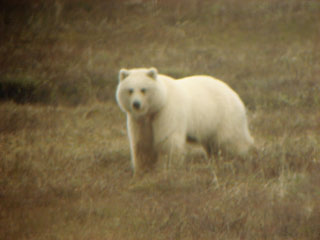 This time we are cautious
and keep a great distance away, creeping up slowly and half hidden by a hill. No
matter where we position ourselves we can barely see into the nest, usually only
seeing the falcon’s tail feathers and folded primaries. John and I start back
across the bridge toward the parked cars, but pause when we notice a car has
just passed and stopped. Just then we see a Grizzly Bear beyond the car and
motion to the occupants now exiting. I line up my spotting scope and digiscope a
series of photos showing the white grizzly, so white in fact and long-haired
that it looks more like a Polar Bear than a Grizzly. When the bear eventually
retreats, I proceed half-way across the bridge and lean over the edge to look
down on the nest, and with my camera extended I snap a photo
This time we are cautious
and keep a great distance away, creeping up slowly and half hidden by a hill. No
matter where we position ourselves we can barely see into the nest, usually only
seeing the falcon’s tail feathers and folded primaries. John and I start back
across the bridge toward the parked cars, but pause when we notice a car has
just passed and stopped. Just then we see a Grizzly Bear beyond the car and
motion to the occupants now exiting. I line up my spotting scope and digiscope a
series of photos showing the white grizzly, so white in fact and long-haired
that it looks more like a Polar Bear than a Grizzly. When the bear eventually
retreats, I proceed half-way across the bridge and lean over the edge to look
down on the nest, and with my camera extended I snap a photo, showing the
Gyrfalcon intently sitting on the nest. I keep walking and the falcon stays on
the nest. We arrive back in Nome in time for Shari’s dinner reservations.
(Shari) Wonderfully realizing I do not have to get up, I turn over and go back to sleep when I hear Bert at 5 AM. I sleep in this morning, microwave my breakfast and French press some fresh coffee. What a life! Later I pay our room bill and decide to bundle up to find a geocache. May takes me through streets I have never walked in the past and I must stick out like a sore thumb with my white hat, red jacket, white skin and mittens looking at a small device in my hand. I walk to the back edge of town, meandering around water puddles and mud on the gravel road. Dogs bark and I do wonder about my safety but I carry on. May takes me close to the community recreation center and luckily no people are milling around to watch me pat down the fence in front of a huge metal storage drum. I find the magnetic key case quickly, but dumb me forgot a pen to log in my find. Oh well, I know I found it. I return to the main street with a satisfied smile and do a little shopping. I don’t find anything shouting my name so return to my room. I catch up on lost sleep from the previous day, do some E-mail, read and watch CNN. The group returns from a successful day and we walk to dinner. Food is good but service is lousy and our order is lost in the shuffle. Finally we get our pizza. Luckily the conversation has been great as I learn more about Ann and Curtis.
(Bert) Our last day in Nome, we take advantage of having four cars and split up into groups for today’s outings. Most of us start off down the Council Highway and head directly to Safety Sound to try finding some of the species that have been reported there, yet missed by us. This time we get out the scopes and make a thorough study as far as we can see on this clear day. Far across the inland lake I see a gull with a back darker than others. More scopes line up on the standing bird and John agrees with me that the back and wing tips look almost the same dark color and the white bar separating them is broad, so we concur that this is a Slaty-backed Gull and soon we see a second one nearby. I scan across the lake again and this time I come upon a loon with high white flanks, separating this Arctic Loon from the similar and more common Pacific Loons.
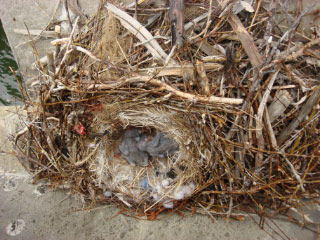
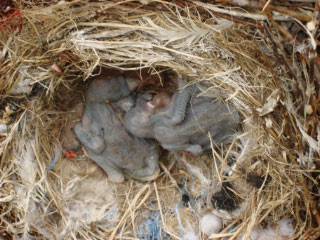
Suddenly a Peregrine Falcon flies out from the bridge and we suspect it must have come from under the bridge. Steve moves to a place where he can see up into the support posts and spies the nest. I move across the bridge to the spot and photograph the nest with two featherless blue chicks. I cannot tell if they are dead or alive. We double back on the Council Highway, stopping at Cape Nome and Nome River, though not finding species we haven’t seen before. Now we drive the Kougarok Road, heading to where we saw the Golden Eagle on the nest – it is still there – and begin a search for Arctic Warblers that presumably nest in this area. We walk nearly two miles along the road, taking turns leapfrogging the cars. We play a recording, either to attract a bird or to refresh our memories on its song. Several times I am fooled by Orange-crowned Warblers which have a similar song but less reedy. I am with Bent when I hear a song I’m sure is Arctic Warbler, but the bird remains distantly out of sight. We are sidetracked by a Wandering Tattler and I take photos since it is relatively close. I meet two men in a pickup and since they are holding binoculars I ask them if they have found Arctic Warbler. With thick accents which sound like Russian to me, they tell me they were on a tour yesterday and the guide stopped the van, got out, played a recording, and instantly the bird appeared, but they do not remember where it was along the Kougarok Road and they have not found one today on their own. We all get in the car and continue another half-mile down the road. I spy a rock cairn at the edge of the road and it seems to me that the guide may have used this marker as a stopping point so that he did not need to search for the warbler he had found on a previous exploration. So I stop, John plays a recording and instantly two Arctic Warblers fly close enough to get quick binocular views. After over two hours of searching, we’ve got our bird. Somehow this way seems like cheating and I’d preferred finding it the old-fashioned way of waiting until I heard or saw the bird on my own. Now hearing the actual bird sing, I’m even more convinced the bird Bent and I heard earlier was also Arctic Warbler.
 We head back toward Nome without stopping again until I turn on the Dexter
cutoff and head uphill on a side road. This is the same one that Shari took
yesterday to search for a Muskox. We are barely out of the cars when I see one
ahead of us crossing the road. We move in its direction and see it amble slowly
through the willows and stop occasionally to munch on grass. We find another and
then two more, all close enough for photos
We head back toward Nome without stopping again until I turn on the Dexter
cutoff and head uphill on a side road. This is the same one that Shari took
yesterday to search for a Muskox. We are barely out of the cars when I see one
ahead of us crossing the road. We move in its direction and see it amble slowly
through the willows and stop occasionally to munch on grass. We find another and
then two more, all close enough for photos of the shaggy hair and downturned
horns, but far enough to feel safe from these enormous strong creatures that
could knock us silly with a single bump.
It is near the end of a good day out in nature and now it is time to repack our luggage, have a bird count (85 bird species, 10 mammal species, 139 collective life birds), shuttle people to the airport, refuel the cars and turn them in. Jim and I walk the mile and a half to the airport and join the others in the waiting room. The plane is late and then Donna whispers to me that the plane has already made an attempt to land in the fog.
(Shari) The loudspeaker rings a tone of attention and a female voice says “I am sorry ladies and gentlemen but I have some bad news. The pilot of Alaska Airline #173 has attempted to make two landings and has failed due to the fog. Before he runs out of fuel he must land in Kotzebue. Your flight to Anchorage this evening has been cancelled. You may approach the ticket counter and we will reticket you for tomorrow’s flight.” Oh my goodness! What am I to do with 18 people? I make a mad dash to the ticket counter, tell Bert to get in the line next to me. I am third in line: not too bad. I have everyone give me their tickets and I will redo the whole group. One, then 2, then 3, then 4, then 5 tickets make it to my outstretched palm. Finally I have all 18 tickets and the young lady behind me says “If you are going to do all those tickets I am going in front of you.” She pushes her way up front but when she gets even with me I say “I THINK NOT.” She backs down and thank goodness she did not play my bluff. One lady has been sitting in the airport since this morning. She could not get on the afternoon flight and looks like she won’t make it this evening either.
I reach the ticket counter and our tickets are redone one at a time. It takes forever and every ticket that gets completed is a relief. I wonder when the plane will fill and no more will get on. About half way through my stack, I learn that the airline has added seats and everyone will get on the morning flight. Meanwhile Donna is calling around for accommodations. Five rooms are available at the Nugget Inn, none at the Aurora, none at any bed and breakfasts. We need 9 rooms. We hear that the Methodist church will allow us to sleep on their floor. Finally the lady at the ticket counter asks if we might like to stay in a two bedroom apartment above the Subway. Boy, would we ever! A couple can take each bedroom and two couples on the living room floor. She says she usually does not do this. She asks if I will be staying there. Then she calls the owner and makes arrangements. We must look trustworthy and desperate for her to consider us. Bert gets out the playing cards, selecting ace through seven, and lets each couple pick a card. Ace through five go to the Nugget Inn and the other two couples will get the apartment bedrooms and we with Jim and Donna will get the living room floor. We retrieve our luggage, get a taxi and discover another room at the Nugget has opened up. Curt and Chris take that one and Steve and Nancy join us at the apartment. We luck out again and discover that the living room has a sofa bed. So everyone has a bed to sleep in tonight and we all collapse at nearly 11 PM. It all works out in the end.